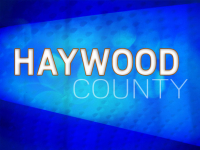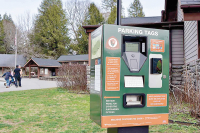Board holds off on land use vote
The Waynesville Planning Board said this week it will hold off on adopting a major update to the town’s land use plan until February at the earliest, and will delay voting even then if it thinks citizens still want time to digest the plan and offer suggestions.
“I will say that people have told me that if we vote at this meeting it would prevent some from commenting,” said planning board member Jon Feichter at the Dec. 20 meeting. “I would be in favor of waiting until at least Feb. 21 to vote.”
Other planning board members agreed to wait until then at the earliest.
“I think we can tentatively schedule it for then, but it can wait until later if that’s what we need to do,” said board chairman Patrick McDowell.
Town Planning Director Paul Benson also said that there should be no rush to adopt the revisions.
“It is my recommendation that you vote when you feel comfortable with it. Tonight would be too early,” said Benson.
Benson told board members he would like them to delay voting and take public comment at its next couple of meetings.
The updates to the town’s land development standards have been in the works for more than a year. Waynesville hired a consulting company that has been working with a town committee to update the land-use standards that were originally adopted in 2003. Nearly 40 meetings have been held, and result of that work was presented to town citizens at two public meetings in late November and early December.
Benson prepared a package of all the comments for the planning board, but he said two issues raised by the public stood out: one, criticism of the revision that will remove the mandate that parking be on the side and in backs of buildings in commercial areas; and two, complaints about the new plan’s allowable density and height.
The board did not discuss any changes to the original proposal in response to public comment from the two public meetings.
Feichter did bring up one problem that he said might need to addressed: the stipulation that redevelopment of existing structures did not have to meet the new standards as long as the revision was to less than 50 percent of the existing structure. He said some could take advantage of this if there was not a time limit put in the regulations saying how long a period there had to be between renovations.
Benson suggested that saying a year must pass between renovations would likely solve this problem, but the board did not adopt any change.
New regulations are a compromise
Editor’s note: This letter was written by Waynesville’s planning director in response to Mary Lamb’s letter above.
Dear Ms. Lamb
Thank you for copying me on your message to Mayor Gavin Brown. I can’t speak for the mayor, but I was frustrated that most of your questions seemed to be aimed at attacking our process rather than genuine questions to gather information about the draft ordinance. Many people have worked very hard to produce the product that you have attacked even before understanding what it contains. My concern at both community meetings was that your insistent, repetitive and argumentative statements were dominating the meeting to the exclusion of comments from other citizens that pertained to the actual content of the ordinance.
Our steering committee was never intended to be demographically balanced. The criteria for selection was experience with the Town’s development regulations. All were appointed directly or indirectly by your elected representatives. All meetings of this committee were open and members of the media did occasionally attend.
As you have the opportunity to review the draft ordinance, I am hopeful that you will appreciate some of the changes even if you don’t agree with others. Please let us know what you don’t agree with, and how in your opinion it can be improved. That is the type of feedback that will be effective in making the ordinance better.
I’m sure you realize that all development ordinances represent compromise, so it’s unlikely that everyone will be completely pleased with the result of the revision. However, the objective of this process as I see it is to produce a set of development regulations that are more user-friendly and more importantly will make Waynesville a better place.
Paul Benson
Waynesville Planning Director
Residents need time to review zoning changes
To the Editor:
Like so many other young couples, my husband and I felt so blessed when he landed a job in this area five years ago and we were able to move and start a family in Waynesville. We had looked at living in Sylva, but immediately were attracted to the historic character and charm of this dear town and seriously impressed with the well-thought out planning of the downtown, where we currently live.
This interest in being a part of a vibrant, beautiful community led me to attend a meeting hosted by Paul Benson, planner for the town of Waynesville, on Tuesday in which the town’s newly drafted land development standards were presented to the public. Benson explained that over a more than two-year period, a committee appointed by our respected town board reviewed the old land development standards, coming up with a completely new document to be enacted into law — a document that would entirely replace our current standards.
Mr. Benson said that only 10 percent of the current law would effectively be changed; however, the changes he discussed I found to be on very critical issues (parking, setbacks, landscaping, to name just a few). Many of these changes could alter the originally planned landscape, making it appear more and more like suburban strip malls and big box centers of larger cities, not the quaint mountain town we love and that tourists love to visit.
Residents wishing to make changes to improve and protect the character of their neighborhoods have been told that this review process would be their opportunity to organize and make changes. But even after news outlets have advertised the public meeting times, the public still needs ample time to review, digest and discuss the more than 300-page document that is currently the law, along with the new 200-plus page document being proposed to supersede it. These documents are written in entirely different forms, making it very time-consuming to compare and contrast them.
Currently, neither Mr. Benson nor his committee have offered the public an easy to read list of all changes from the old law to the new—only summaries they wish to highlight and that are admittedly incomplete. They are putting the burden of review on the public, a process that again is complicated and lengthy.
Currently, the town planning board is set to begin discussion and possibly even vote on the new standards Monday, Dec. 20. This would only allow concerned citizens two and a half weeks (during the Christmas season) to review it. I would urge interested citizens to contact the Town Board and urge them to delay all voting on this plan until at least March to allow interested citizens time to read, meet and develop their own concerns for consideration.
What is the vision of Waynesville’s residents for their future? A handful of men only have spent two years revising the original standards which were developed and adopted (in 2003) with both men and women actively involved. Allowing folks a couple of months to give feedback is not too much to ask. The standards adopted by the town greatly affect the beauty, character, economic development and general sustainability of our community.
What you can do to help:
1. Email or call the Waynesville Aldermen, the chair of the Planning Board and the Town Planner and ask them in your own words to postpone any vote on adopting the Land Development Standards until at least March.
Mayor Gavin Brown, This email address is being protected from spambots. You need JavaScript enabled to view it., 828.452.2491
Alderman Gary Caldwell, 828.456.3138
Alderman Elizabeth Feichter, This email address is being protected from spambots. You need JavaScript enabled to view it., 828.456-6918
Alderman J. Wells Greeley, This email address is being protected from spambots. You need JavaScript enabled to view it., 828.456.7288
Alderman LeRoy Roberson, This email address is being protected from spambots. You need JavaScript enabled to view it., 828.456.7142
Town Planner Paul Benson, This email address is being protected from spambots. You need JavaScript enabled to view it., 828.456.2004
Planning Board Chair Patrick McDowell, 828.508.4932
2. Attend the Waynesville Planning Board meeting at 5:30 p.m. on Monday, Dec. 20, in the upstairs room of the new downtown police station to ask the entire planning board to postpone their critical vote on this issue until at least March.
3. Forward this letter and info to anyone Waynesville residents you know who are concerned with Smart Growth, historic preservation and maintaining the character and charm of our community. Post information on any Facebook or other social networking site you regularly use to contact your Waynesville friends, family, co-workers and neighbors.
4. Contact me with your other ideas on how we can work fast to take advantage of this window of opportunity for making positive change in our community. A small group of concerned citizens is currently forming to carefully review the new plan and we would love your help.
Mary Alice Lamb
Waynesville
Lomo owners sell to Atlanta entrepreneur
The inside of Waynesville’s 44 Church Street does not, today, bustle with life, warmth and the scintillating scent of food wafting through the air, as it once did. The former home of the storied Lomo Grill is cold and empty; the open wood oven is not fired up, and chairs and tables are stacked in a corner, across from an empty bar and a kitchen counter cluttered with what looks like detritus from a hardware-store explosion.
Downstairs, old water heaters sit forlorn and disused by the back door and small buckets catch dripping water.
But this is not the start of another sad story on small businesses shuttering. This is the opposite story, one of success leading, hopefully, to new success.
When Lomo Grill, a 16-year resident of downtown Waynesville, closed its doors and papered its windows in November, owners Ricardo and Suzanne Fernandez ended the restaurant’s prosperous run right in the midst of that success. They were juggling the restaurant with two other ventures – Chef Ricardo’s Sauce, a business that grew unexpectedly out of the chef’s famed tomato sauce, and a farm that specializes in peonies and fig trees. While they loved the restaurant, said Suzanne Fernandez, the sauce business was exploding. Their product was picked up by Earth Fare and Whole Foods, and the juggle, she said, became too much. It was time to choose, and when they decided to close the Lomo Grill chapter of their lives, all they needed was a buyer for the space.
Enter Kaighn Raymond, an Atlanta chef renowned for opening award-winning restaurants in the Southern metropolis. Raymond had long dreamed of opening his own place and his eye on Waynesville from the time his parents moved here. He and his wife, Tania even got married in Maggie Valley. But his culinary career required him to stay in Atlanta, building up enough experience and capital to branch out of the city and into his own venture.
“I’m able to finally get out of Atlanta and do what I really want to do, which is opening my own place in a small town,” said Raymond as he worked on repairs in the former Lomo Grill last week.
His new spot, which will be called Frog’s Leap Public House, will feature, he said, a local atmosphere with tasty, local food at affordable prices. He’s interested in serving farm-to-table fare that showcases local farmers as much as possible, offering a simple menu that captures the flavor of its location.
“When people leave, I want them to have a real sense of what Waynesville and Western North Carolina are about,” said Raymond.
But first, there is work to be done. Raymond is giving much of the restaurant an overhaul in anticipation of a spring opening. As he walked through the empty restaurant, he rattled off a laundry list of renovations and repairs, from floors and ceilings to new dishwashers and upgraded bathrooms. The drip buckets aren’t for leaks, but are catching the aftermath of an overall hose-down Raymond had given the kitchen with a pressure washer. The old water heaters had been replaced with new, and new coats of paint were starting to make their way up walls in the basement.
Although he concedes that it’s a massive undertaking in an economic climate that is less-than-friendly to new restaurants, he’s excited to be at last starting on his dream. And he thinks the combination of his culinary success and business knowledge — his father was a career banker — will give him and edge and maybe help him stay afloat.
For their part, the Fernandezes are pretty thrilled, as well, to have finally sold the property. Now they can devote their full attention to their new ventures.
“We are so grateful for the experience of being in downtown Waynesville for as long as we were, and we really love our customers and still keep in touch with many of them,” said Suzanne Fernandez. “We just decided that, after 16 years of the restaurant, that it’s time to devote more time to these two things.”
Ricardo Fernandez, the culinary creator that was behind Lomo Grill, said he won’t really miss the day-to-day life of a restaurateur; he’s got plenty of food-related fare to keep him busy.
“My hands are always here at the farm, working and propagating and also producing the sauces and going to food shows, so there’s always involvement in creating new things related to food,” said Fernandez, adding that he may even entertain a foray into cookbook writing. But, really, he said, the bottom line was that the sale was necessary to keep the other businesses thriving.
“We needed more time to develop this marketing and the only way to do it was through selling the restaurant,” he explained.
And with over 350 varieties of peonies in the ground at their farm and two new sauce varieties on the way, the couple thinks they will have their hands more than full for the foreseeable future. They’ve said they don’t intend to leave the area that has been their home for so long.
“We feel like we were very much a part of the evolution of Waynesville to what it is today,” said Suzanne Fernandez. “We believe in Waynesville.”
Her husband echoed those sentiments.
“We will continue trying to expand what we have here,” he said. “We have 36 acres and we’re pretty happy where we are.”
Kaighn Raymond isn’t complaining, either. Once a visual artist who left the craft to pursue artistry in food, Raymond believes in making beautiful, affordable food, and he’s ready to be doing it in his own place.
“I told my father, ‘when I’m 40, I’ll be ready to open my own place.’ Well, I’m 41 now,” Raymond says, laughing. “Although it will be tough, by doing things the best we can, we’ll succeed.”
Photography stands out among a mixed bag of interest
Putting all of Ed Kelley’s interests in separate, tidy little boxes just doesn’t work.
There’s no way to separate Ed from Ed’s photography; or Ed’s photography from nature; or nature from Ed’s philosophy. There is also Ed Kelley the artist, the musician, the businessman, the husband, the father and the hiker.
When you approach one you get them all – not wrapped into a neat, tidy package but more like a large balloon half-filled with water, and as soon as you feel like you have your hands around the “real” Ed, the water shifts and Ed flows effortlessly, knowledgably and comfortably into another aspect of the balloon.
According to Kelley, he was a teenager before he began to discover the natural world that surrounded him in Haywood County and across Western North Carolina.
“I was 15 or 16 when I hiked to the top of Mt. Pisgah with a friend who was in the Boy Scouts. I was blown away by the view. All the years I had lived here and I had never seen this,” said Kelley, who owns Ridge Runner Naturals Gallery/Studio on Main Street in downtown Waynesville with his wife, Jo, a painter. The studio/gallery is adorned with Jo’s and Ed’s original artwork, including many examples of Ed’s nature photography.
Kelley said not long after that experience he got his drivers license and more and more trailheads in the area became accessible. But, he said a major shift occurred when he was a music major at Mars Hill College.
“They had what were called ‘mini-mesters’,” Kelley said. According to Kelley, a mini-mester was about a month-long class between the traditional fall and spring semesters.
“They had a backpacking class, and I signed up,” he said. “It was the first time I had ever been in Shining Rock Wilderness. We had to bushwhack from (U.S.) 276 up to Shining Rock. Then we hiked over to Sam’s Knob and back. We were out there for a couple of nights and it was awesome.”
Not long after that trip, Kelley nixed the music program at Mars Hill and enrolled in Forestry at Haywood Community College. That just served to cement his connection to the out-of-doors.
“We were in the field all the time,” Kelley said. “We had class in the woods; we would cruise timber or learn tree identification and there, I met a good friend who had the same kind of drive for the outdoors that I did.
“We both wanted to learn and see more and more. We went on lots of bushwhacking trips together. We would just get the maps out and say – look we can go from here to here – and we would set out.”
Kelley said there is a good reason his business was named the “Ridge Runner.”
“When we would get the maps out we would look at the ridges. The ridges are the connectors. We didn’t know if there would be trails or not but we knew we could follow the ridges.”
Second nature
Kelley said his attraction to photography predated his hiking addiction.
“I remember being in Washington, D.C., when I was in the seventh grade. I had this little box camera and I went all over town taking pictures,” he said.
“Not long after that I bought an old Canon FX from a photographer friend of the family. It was completely manual. I had a 50mm, a 125mm and a 28mm wide-angle lens and I took that camera with me everywhere. If I was hiking it was in my backpack,” Kelley said.
Looking back, Kelley said he is glad that he learned about photography from his old manual Cannon.
“I learned about light and aperture and shutter speed because all of that had to be done manually. It’s ingrained in me now, and when I go out I can concentrate on the composition of the photograph,” he said.
“Sometimes, now, I will hike to a specific spot at a specific time just to get one certain photograph. I’ve been there before and I’ve seen the scene and I know what time to be there for the best light,” Kelley said.
“Of course there are other times when I just grab my camera and head out to see what I might find.”
Asked to rank light, equipment, subject matter and composition or eye in some sort of photography hierarchy, Kelley said he felt the number one consideration was lighting.
“Everything else being equal, lighting will make or break a photograph,” Kelley said. “The best subject in poor lighting will result in a poor photograph, where a somewhat mundane subject in perfect lighting can produce an exceptional photo.”
Kelley ranked composition — being able to see in your mind’s eye what the finished photo will be, second. He ranked subject third and equipment fourth.
“There is so much decent photographic equipment out there today, that if you learn about light and shutter speed and aperture, and composition you’ll be able to get good photos.”
His favorite times of day to shoot are dawn and dusk.
“The light is just so much warmer then – it kind of embraces the subject instead of just lighting it.”
His favorite season is winter. ‘Because of the lower angle of the sun, you get that warm light for a longer period of time.”
A perfect storm
Kelley thinks the woods and mountains and balds are great. And he believes people can’t help but benefit spiritually and physically by spending time out doors. And for him, adding photography to his walks in the woods just increases his enjoyment. It nurtures his artistic spirit as well as his physical and mental wellbeing.
“I need that balance in my life,” Kelley said.
To see what that balance looks like go to www.edkelley.com.
Public to hear about proposed changes to Waynesville land-use ordinance
A proposed update of Waynesville’s progressive land-use ordinance that has been several years in the making is close to becoming law, as planners gear up to inform the public at two information sessions next week.
The new ordinance will update a plan that hasn’t been changed since 2003, which Waynesville Planning Director Paul Benson says is too long.
“It was due,” said Benson. “It [the ordinance] was adopted in 2003 and, honestly, wasn’t that well developed. There’s been a pretty steady drumbeat of complaints about parts of the ordinance, particularly the parking-in-front portion.”
Benson is referring to a clause in the ordinance that requires new buildings and larger renovations to locate their parking either behind or to the side of the building to present a more pedestrian friendly, urbanized feel to new development in the town.
According to Benson, 85 percent of the ordinance will remain unchanged since, he said, the ideas behind the 2003 version were solid, if the execution was sub-par.
Among the substantive changes to go into effect, perhaps the most powerful is the creation of Condition District zoning, which allows the board of aldermen to create a negotiated, site-specific zoning districts on a case-by-case basis, allowing them to make exceptions for certain developments that meet particular criteria. This change has, however, already been enacted ahead of the rest of the new ordinance after Ingles lodged a special request with the board.
Other changes will include less vagueness in design standards, increased protections for open space in high-density residential areas, and more relaxed slope regulations to allow denser development on slopes with less than 25 percent grade.
Another key feature will be an update to the parking regulations, which would vary by district and building type. For regional business districts like Russ Avenue, the new rules would allow up to 50 percent of required parking to be out front.
The new standards will also give developers some leeway in their landscaping choices, particularly around where to put plants in parking lots.
Benson said he hopes that the meetings, to be held Nov. 30 at the Waynesville Recreation Center and Dec. 2 at the Waynesville Fire Station No. 2, will allow residents who might be impacted by the changes to get their questions answered.
“It’s an opportunity for people who are interested to come in and learn about it and have input,” said Benson, “and for people with specific issues to come in and see how those are being handled.”
The sessions will begin at 6 p.m and will feature a presentation detailing the changes as well as displays and opportunities for residents to comment and ask questions.
Benson said he also hopes to have a form for questions and comments available both at the meeting and online, so those who are interested can formulate and submit questions after the meetings close.
Public meetings:
• 6 p.m. on Nov. 30 at the Waynesville Recreation Center.
• 6 p.m. on Dec. 2 at the Waynesville Fire Station # 2.
Honoring a lost art
By Kristen Davis • Contributing Writer
The newest piece of public art in downtown Waynesville — a metal railing that depicts a mountain scene — could have been crafted centuries ago.
The artists, Richard Coley and Ben Kastner of Wilmington decided to forego modern technology and built the structure using traditional blacksmithing techniques. Starting with 20-foot pieces of metal, Coley and Kastner heated up the metal in a forge and then hammered each bar into their desired shape. No corners were cut with modern machines; even the holes in the metal were hand-punched rather than drilled.
“[Blacksmithing] is a lost art,” Kastner said. “With the machine age, everyone went to machine parts. We’re trying to take it back to the simpler way of doing it. When it’s handmade, you can really see the craftsmanship.”
What used to be straight pieces of metal are now twisted elegantly into a mountain skyline with trees, a church steeple, and three salamanders in honor of the Great Smoky Mountains as the “Salamander Capital of the World.”
The railing will be installed at the mini-park near the corner of Main and Depot streets this week. The intersection holds historic significance as the site that was once overlooked by a large arched sign that indicated the eastern entrance of Great Smoky Mountains National Park. Franklin D. Roosevelt rode beneath the sign on his way to the dedication ceremony for the park in 1934. These aspects of the town’s history inspired the Waynesville Public Art Commission’s theme for the railing — “Art Connects the Parks.”
Kastner explained that the installation could take one to three days.
“Installs are something you never really know what you’re getting until you get there,” he said. “We have to drill these 3-inch holes in the wall, so there could be unseen obstacles at the job site.”
Unexpected setbacks notwithstanding, the artists plan to have the railing installed by the dedication ceremony, which will occur at 4:30 p.m. on Friday, Nov. 19, at Gallery 86. According to Kaaren Stoner, the public art commission chairman, the ceremony will last about a half hour, and the featured speakers will include: Mayor Gavin Brown; a representative from Smoky Mountain National Park; Bill King, vice chairman of the Public Art Commission; and the two artists.
This project is the first public art commission Kastner and Coley have received. Kastner called it “one of the best opportunities” he and their shop have ever had. They were selected for the commission after responding to the Waynesville Public Art Commission’s call for artists throughout North Carolina and Tennessee to design a railing that could represent downtown Waynesville’s historic connection to Great Smoky Mountain National Park, beating out the other 25 artists who applied.
Kastner said he and his business partner/fellow artist/friend have been working 12 to 15 hour days to finish the project by their deadline.
“People will enjoy it for years to come, so I don’t mind spending the extra time when so many people can enjoy it,” he said. “It’s rewarding to think that it’s not just for one homeowner to enjoy behind closed doors.”
Kastner’s interest in metal-working sparked in high school when he took a welding class outside of his regular class schedule. Eventually, he and Coley, his friend since high school, attended the College of Oceaneering in California to learn underwater welding. While there, they both worked part-time at a blacksmith shop, which reoriented their interest toward more traditional ironworks.
“There’s only so much you can do with welding,” Kastner said.
He prefers the challenge that blacksmithing provides him.
“You can always get better at it, you can always learn more,” he said. “It’s always exciting to think about the things you can learn from other people. It’s not the same thing everyday like your average job.”
The “Art Connects the Parks” project is the third major public art installation to grace the streets of downtown Waynesville, thanks to the efforts of the Public Art Commission. The first project “Old Time Music,” constructed by Stefan Bonitz, was installed on the corner of Miller and Main Streets in 2008 and features two rosy-cheeked, grinning musicians — one playing banjo and the other on a washtub bass. The second project “Celebrating Folkmoot,” by renowned public artist Wayne Trapp, waves its flags in the wind on the corner of Main and East streets.
The public purse was not opened for any of the three public art projects. All were funded with private donations, Stoner said. The $20,000 commission for “Art Connects the Parks” comes from individuals, local businesses and a grant from the Haywood County Tourism.
This past June, the Public Art Commission raised much of the commission funds with its “Salamander Splash” event at HART Theater, where there was an art auction of more than 48 works of art — paintings, jewelry, pottery, quilted wall art and metal — all featuring the “Salamander Capital of the World” theme and made by Haywood County artists.
The Waynesville Public Art Commission, established in 2006, evolved out of the StreetScapes Committee, which raised funding for rotating temporary art for the town’s public spaces from 1999 to 2004. The success of the StreetScapes initiative caused enthusiasm for implementing permanent public art.
“I’d like to thank the town for giving us this opportunity,” Kastner said. “It’s opened some doors and changed the course we’re heading by getting us away from the architectural side of things and into public art. We feel like there’s more of a purpose to it because more people can enjoy it.”
Since receiving their first public art commission, Coley and Kastner applied for another one in Kinston, for which they are designing a bandstand to honor the African American Music Trail. They were selected as finalists and will turn in their design next week, Coley said.
Waynesville adopts conditional zoning at Ingles’ request
Ingles is now one step closer to giving their Waynesville store a revamp, thanks to a decision taken by the town’s aldermen last week.
The board granted Ingles request for a conditional zoning district, which would allow the supermarket chain to go ahead with their redevelopment plans without any delays in the process.
Conditional zoning districts are slated to be part of the town’s updated land-use ordinances that will be open to public comment later this fall. Ingles, however, couldn’t wait that long, so they petitioned the board to make a decision now.
After meetings between town officials and Ingles representatives, the board seemed convinced that the grocery store wasn’t seeking to get in under the wire by pushing through a project before the updated ordinances are adopted.
Mayor Gavin Brown said that, initially, he’d harbored reservations.
“At first I had some reservations about what we were doing here,” Brown said. “At first I was a little suspect of having all that authority and all that power. The nice thing is that if we don’t like it, we don’t have to do it. It’s really our decision to make within the confines of the ordinance itself.”
Michael Egan, attorney for Ingles and also an expert on zoning, spoke on behalf of the store, assuring the aldermen that the request wasn’t frivolous.
“They didn’t just file this application out of a spirit of playfulness. It’s very important to them. It’s critical to them to get started as soon as they possibly can,” said Egan, who has helped Brevard and other local municipalities put together similar measures.
“It’s a terrific tool,” said Egan. “It’s probably the best tool that local governments now have.”
For the town, adopting conditional zoning will allow them to make exceptions to current zoning on a case-by-case, plat-by-plat basis.
“It’s very site-specific,” said Paul Benson, Waynesville’s planning director. “You can tailor it to an individual and so that makes it really a popular tool.”
It is also a powerful tool, giving the planning board and the board of aldermen the power to change and negotiate around current zoning regulations for specific businesses or individuals.
There are, said Benson, some restrictions, though.
“The most specific restriction is they can’t ask for a use that’s not allowed in the underlying zone,” Benson said, which does limit the amount of leeway that a board can offer.
For Ingles, the crux of the issue is timing. Under the current regulations, they couldn’t redevelop the site — which is in the Russ Avenue Town Center District — much beyond minor renovations without bumping up against the ordinance’s confines. Within those boundaries, developers said, it would be impossible for them to update, since the store lies on what Benson calls a “flagpole lot.” That makes parking in the back or side of the building — a stipulation for buildings in the district — difficult.
Ingles hasn’t come out with definitive plan for what it wants to do with the site, and Benson said the town won’t know for sure until their application arrives. That’s when the real negotiations over what will and won’t be allowed in the conditional zone — or even if they’ll be allowed one — will begin.
The possibility of expansion eastward into the adjoining storefront once occupied by Goody’s has been mentioned, as has the idea of a gas station, which is the formula Ingles has been following for its newer stores. At Tuesday’s meeting, store representatives pledged that the expansion would bring up to 60 new jobs to the community, in addition to temporary contracting jobs that the redevelopment would create.
Egan said that the major negotiating points of the new conditional use would likely be parking and landscaping, and said that they hope to have an application for conditional use filed with the city in time to make an appearance on the Dec. 20 planning board agenda.
“The engineer is working on those plans right now and we hope to have that application in by the end of the month,” said Egan.
The next step is for the town to evaluate the store’s application and start talks to work out exact terms. Benson said that, if the timing is right, that process could be well on its way by early next year.
‘Art Connects the Parks’ to be dedicated Nov. 19
Waynesville will dedicate its third public art project during a dedication ceremony at 4:30 p.m. on Nov. 19 at Gallery 86.
The project — an artistic railing representing Waynesville’s connection with the Great Smoky Mountains National Park — will be installed at the mini-park at the intersection of Main and Depot streets. Ben Kastner and Richard Coley of Wilmington will install their piece the week of Nov. 15.
The theme for the railing is “Art Connects the Parks.” This Waynesville intersection was once the location of a large arched sign indicating the direction of travel, down Depot Street, to the eastern entrance of Great Smoky Mountains National Park.
The railing design contains layered mountains, handcrafted trees, a recognizable Waynesville church steeple, and in honor of the designation of the Great Smoky Mountains as the “Salamander Capital of the World,” three salamanders.
Salamander Splash, a very successful fundraising event was held June 24 at HART Theater, and the “Salamander Capital of the World” theme continued with an art auction of more than 48 custom works of art — paintings, jewelry, pottery, quilted wall art and metal made by the artists of Haywood County. The artists contributed their talent and energy to the effort to raise the $20,000 commission for the railing.
All of the $20,000 commission was raised from private individuals, area businesses and a grant from the Haywood County Tourism Development Authority.
This is the third major public art installation in Downtown Waynesville. “Old Time Music,” at the corner of Main and Miller streets, and “Celebrating Folkmoot,” in front of the police station and development ofice, were dedicated in 2008 and 2009 respectively. All money for the artworks come from private donations.
Historic Shelton House hosts Ghosts and Goblets event
Pale glimmers of subdued lighting casting shadowy silhouettes against a backdrop of muffled voices will transform the historic Shelton House from a gallery where artifacts, crafts and valuable artistic pieces are displayed in an eerie setting where ghostly tales are relayed.
The Museum of North Carolina Handicrafts at Shelton House will host the second Ghosts and Goblets event from 7 to 8:30 p.m. on Oct. 23, with the storytelling program lasting approximately one hour.
Those wishing to attend, including children age 10 and up, should come to the Shelton House Barn where small groups will be assembled throughout the evening. Goblets of wine and juice as well as light refreshments will be available in the barn before or after the visit with storytellers. Refreshments will be served until 10 p.m.
Storytellers will be situated in various rooms in the historic Shelton House and will mesmerize the audience with tales of ghostly encounters, strange occurrences and spectral visits — blurring the line between real, surreal and supernatural. No goblins or monsters will startle from behind a creaky door, but the tales relayed will impress the audience with their potential for hazy connections between imagination and actuality.
The Museum of North Carolina Handicrafts is celebrating its 30th anniversary affiliation with historic Shelton House, built in 1875. Ghosts and Goblets is one in a series of events and fundraisers held in 2010 to support the upkeep of the house and the museum collection. Tickets are $10 at the door.
Shelton House is open May through October, Tuesday through Saturday, from 10 a.m. to 4 p.m. Curator Jackie Stephens is available to give tours and introduce visitors to the history of the house, its original owners, and the extensive craft collection.









